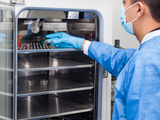Different Lab Safety Cabinet Types and Uses
Laboratory settings have strict guidelines and rules to prevent contamination for a reason. Contamination, especially in biological laboratories, can cause studies to fail and put employees at risk. To minimize the dangers of contamination, many laboratories feature safety cabinets. If you’re unfamiliar, keep reading to discover the different lab safety cabinet types and their uses.
Types of Lab Safety Cabinets
Lab safety cabinets are classified into three main categories: Class I, Class II, and Class III biosafety cabinets. From here, these main categories may be split into even more types of models. Biosafety cabinets share the same main function—they are enclosed workspaces designed to maintain a controlled, safe environment.
Class I
Class I cabinets are designed to provide ventilation and environmental protection for those working inside. This enclosed space helps prevent environmental factors from affecting experiments and other laboratory processes. One aspect that limits the applications of the Class I cabinet is that their design doesn’t protect from contamination—only environmental factors. With these design features in mind, you can safely use any agents that require Biosafety Levels 1, 2, or 3 in a Class I cabinet.
Class II
Class II cabinets also protect the user from environmental factors, but this variety also protects the samples as well. Another notable design of Class II cabinets is that they split into a few sub-varieties: A1, A2, B1, B2, and C1 cabinets. These sub-varieties differ through their filtration methods, inflow velocities, and exhaust systems. Class II cabinets are the next step up from Class I in terms of safety and control. Though, like Class I, these cabinets are also safe for using Biosafety Level 1, 2, and 3 agents.
Class III
Class III cabinets provide the maximum level of protection when it comes to lab safety cabinets. These cabinets are also referred to as “glove boxes” for their completely enclosed, ventilated spaces. The space is gas-tight and offers the most protection against contamination. They even possess material and equipment sterilizing features. Due to this increased protection, Class III cabinets have the most applications when it comes to handling potentially hazardous materials. These cabinets are fit to handle Biosafety Level 1, 2, 3, and 4 agents.
Professional biological studies laboratories are outfitted with many impressive features to conduct studies, one of these features being safety cabinets. This breakdown of the different lab safety cabinet types and uses demonstrates why it’s so important to have a controlled space in a lab environment. If your lab needs more equipment, such as a closed loop extractor and more, check out USALab for all your equipment questions and needs.
Explore Popular Articles
How a Vac Oven Can Revolutionize Your Drying Process
In industries where precision drying is critical – such as pharmaceuticals, food processi...
Secrets to Mastering the Vacuum Purge: Process for Cleaner Extracts
Modern extraction systems pull out most solvents quickly, but those last traces demand careful...
Maintenance and Care 101: How to Prolong the Lifespan of Your Vacuum Oven
Vacuum ovens are indispensable in industries like pharmaceuticals, electronics, and cannabis process...




